Mix cow dung and soil, and add urine infused with metabolized antibiotic. Washington State University researchers have found an unlikely recipe for antibiotic resistant bacteria.

"I was surprised at how well this works, but it was not a surprise that it could be happening," says Doug Call, a molecular epidemiologist in WSU's Paul G. Allen School for Global Animal Health. Call led the research with an immunology and infectious disease Ph.D. student, Murugan Subbiah, now a post-doctoral researcher at Texas A & M. Their study appears in a recent issue of the online journal PLOS ONE.
While antibiotics have dramatically reduced infections in the past 70 years, their widespread and often indiscriminate use has led to the natural selection of drug-resistant microbes. People infected with the organisms have a harder time getting well, with longer hospital stays and a greater likelihood of death.
Animals are a major source of resistant bugs, receiving the bulk of antibiotics sold in the U.S.
The scientists focused on the antibiotic ceftiofur, a cephalosporin believed to be helping drive the proliferation of resistance in bacteria like Salmonella and E. coli. Ceftiofur has little impact on gut bacteria, says Call.
"Given that about 70 percent of the drug is excreted in the urine, this was about the only pathway through which it could exert such a large effect on bacterial populations that can reside in both the gut and the environment," he says.
Advertisement
"If our work turns out to be broadly applicable, it means that selection for resistance to important drugs like ceftiofur occurs mostly outside of the animals," he says. "This in turn means that it may be possible to develop engineered solutions to interrupt this process. In doing so we would limit the likelihood that antibiotic resistant bacteria will get back to the animals and thereby have a new approach to preserve the utility of these important drugs."
Advertisement
Source-Eurekalert











